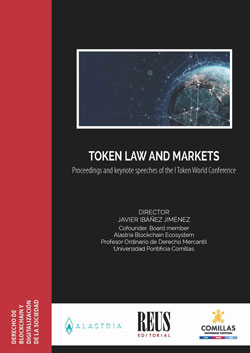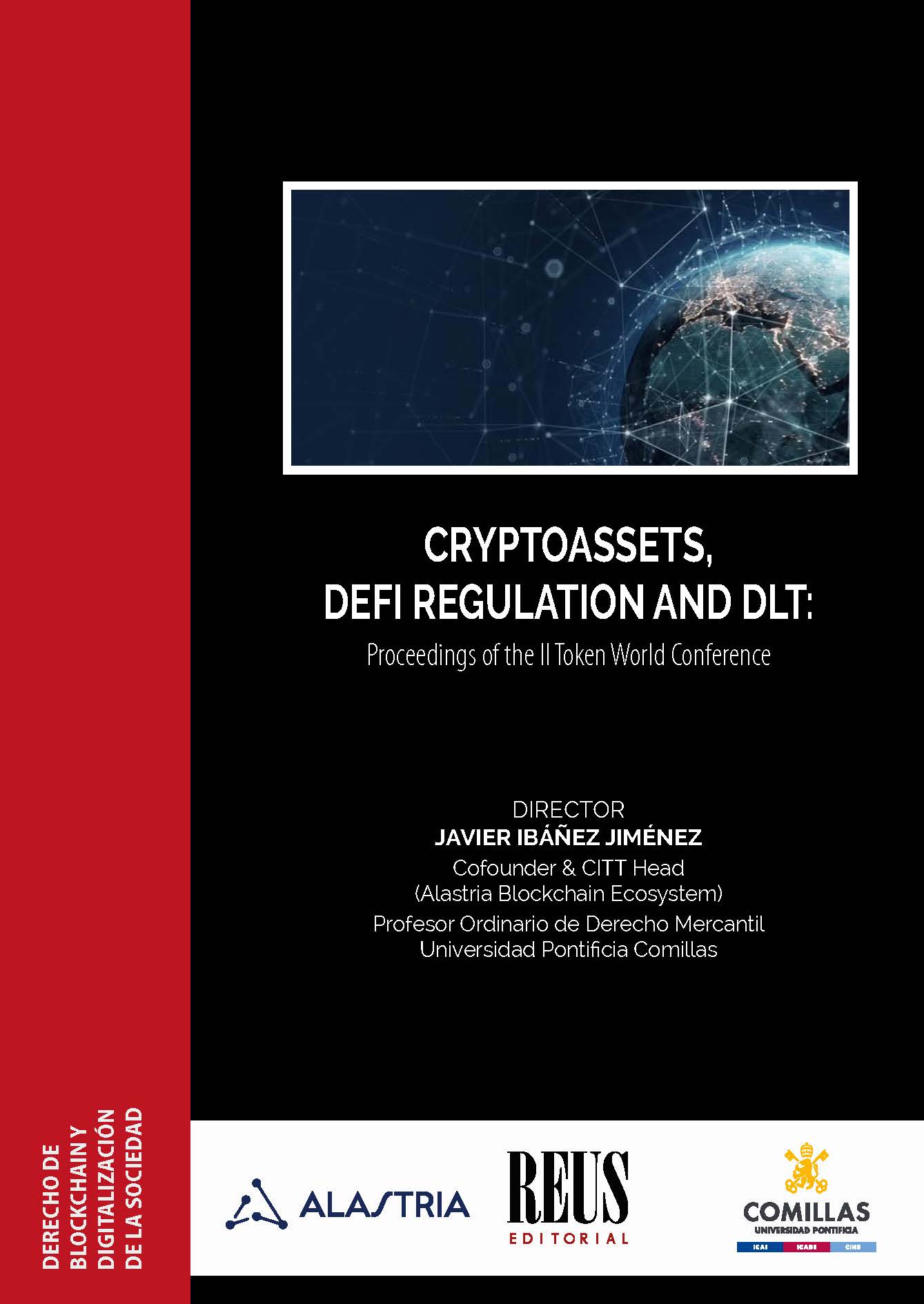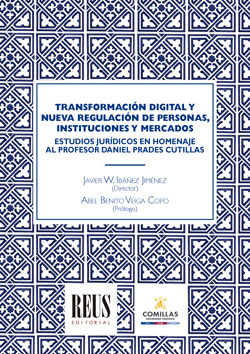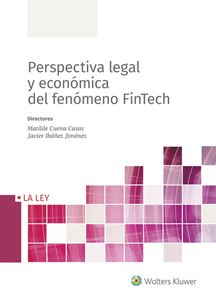Token law and markets
proceedings and keynote speeches of the I Token World Conference
- ISBN: 9788429025484
- Editorial: Editorial Reus
- Fecha de la edición: 2021
- Lugar de la edición: Madrid. España
- Colección: Derecho Blockchain y Digitalización de la Sociedad
- Encuadernación: Rústica
- Medidas: 24 cm
- Nº Pág.: 194
- Idiomas: Español

The first Token World Conference, held in Madrid from 6th to 9th of March of 2021, was organised by the director of this book, head of the CITT —Technology and Transfer Research Commision— of Consorcio Red Alastria, the first Spanish —and European— private-law association to create a blockchain / DLT consortium to set public-permissioned DLT networks), at the Comillas Pontifical University (Madrid).
Roughly thirty world leading blockchain and DLT experts from ten countries contributed to this academic and professional enriching forum, wherein exhaustive keynotes and round tables were offered by means of both streaming and live presential channels for an enthusiastic audience.
As a result of the collected proceedings of the conference, this monograph on token law and tokenomics shows the advances in American and European token law, emphasizing the essential issues posed by the new Digital Finance Strategy for DeFi and for tokens markets, encompassing the three Proposals of Regulations (MiCA tokens, market infrastructures and DORA regime), and other challenging matters for the future of EU digital cryptoasset regulations, foreseeably duplicated for MiFID 2 and MiCA markets.
Economic substantial problems were also treated by some of the speakers, in crucial matters as tokenomics, bitcoin, cryptocurrencies, ICO/STOs, CBDCs or industry DLT network practice.
The expertise of INATBA speakers and public and private financial-market representatives (including the President of Spain’s securities markets authority, CNMV) boosts the value of this Conference, particularly those from INATBA (International Association for Trusted Blockchain Applications), leading NGO present at the regulatory DeFi-pack processus) who have significantly influenced in the amendments of the MiCA regulation, some of them prepared by Prof. Ibáñez and other Keynote speakers at the INATBA MiCA Task Force.
Opening session of the I World Token Conference, Mariano Ventosa
The future of investment tokens: battle lines are drawn, Siän Jones
MiCA Regulation: legal matters still pending, Javier Ibáñez
I. Foreword
II. Specific legal matters still pending or difficult to cope with for the MiCA regulator, in accordance with the September of 2020 published text
III. Common legal problems still unsolved at both sides of the Atlantic Ocean in cryptoasset regulation
IV. Other relevant issues brought to MiCA Regulation beyond the scope of traditional security markets or exchanges for the trading of quoted instruments
Short-term horizon for DLT public-permissioned networks in Europe, Jesús Ruiz
I. Introduction
II. The role of public-permissioned DLT networks
III. Towards trusted DLT and tokens for the common good
What does the MiCA regulation offer in terms of privacy?, Jörn Erbguth
I. Definition of distributed ledger technology (Art. 3.1.1)
II. Privacy coins
III. Decentralized finance
IV. Publication requirement
V. Publication of decisions and penalties
VI. Assets in exchange for personal data are not considered to be free
VII. Conclusion
Token taxonomy in MiCA Proposal and data protection issues, Xavier Foz and Teresa Pereyra
I. Token taxonomy in MICA Proposal
II. Data protection issues and MICA proposal
Applicability of US money transmission regulation to tokens, Adam Fleisher
I. Introduction
II. U.S. State Money Transmission Licensing
III. U.S. State Standalone Virtual Currency Licensing
IV. US Federal Bank Secrecy Act
V. Conclusion
Presentación del libro “Tokens-valor (Security tokens). Régimen de los criptoactivos negociables y sus mercados (MiCAs)” Reus ed., Madrid (2021), Carmen Alonso Ledesma
La regulación jurídica de la inteligencia artificial, Moisés Barrio
I. Introducción
II. Concepto de inteligencia artificial
III. Modalidades
IV. Algunos problemas jurídicos de la IA
V. Iniciativas de la Unión Europea sobre la inteligencia artificial
VI. El Libro Blanco de la Comisión Europea sobre Inteligencia Artificial
VII. La Propuesta de Reglamento del Parlamento Europeo y del Consejo por el que se establecen normas armonizadas sobre inteligencia artificial (Ley de Inteligencia Artificial) y se modifican otros actos legislativos de la Unión
VIII. Propuestas del Parlamento Europeo
IX. Iniciativas de los Estados miembros
X. España
XI. A modo de conclusión
Building next-generation institutional Digital Market Infrastructures (DMI), Tim Grant
I. Foreword
II. A note on SIX Digital Exchange
III. The old and the new market infrastructures
IV. Attracting global integrated institutional liquidity in SDX
V. Tokenization and the NFT movement
VI. The forthcoming SIX - SDX business model
VII. Conclusion: the future of SDX
Sustainable asset-referenced tokens: regulatory and technical aspects, Suzana Maranhâo and Javier Ibáñez
I. Introduction
II. Fungible Tokens
III. Non-Fungible Tokens (NFT)
IV. Purpose-driven Tokens
V. Some additional concerns
VI. Regulatory issues
A) United States
B) European Union (MiCA Regulation)
VII. Conclusions
Security tokens and issuer funding: legal concerns in MiCA Regulation, Ana Felícitas Muñoz
I. MICA/MIFID. EU framework for cryptoassets
I.1. The taxonomy of cryptoassets
I.1.1. Cryptoasset in relation with the Asset: Tokens that exist off the chain and native token
I.1.2. Moving on the EU framework and classification in the MICA and MIFID
I.2. Concerns: Hybrid nature of certain cryptoassets and risk of duplicity regulation
II. Issuer in the EU framework of cryptoassets
II.1. Definition of “Issuer” as “legal person” in MICA for all types of cryptoasset
II.2. The status of the offeror
2.2.1. Issuance and issuer in relation of the type of crypto-asset offered
2.2.2. Some features of the corporate governance and civil liability accordingly the issuer. Comparative table
Tokens referenciados a activos, monedas digitales de banco central y las stablecoins: naturaleza y riesgos regulatorios a la luz de la propuesta de Reglamento europeo (ARTs, CBDCs and stablecoins: nature and regulatory risks), Pablo Sanz Bayón
Asset tokenization: challenges, benefits and guidelines, Luis Martínez
I. Introduction
II. Asset tokenization
III. Benefits and challenges of asset tokenization
III.1. Benefits
III.2. Challenges
IV. How to succeed in tokenizing assets
V. Conclusions
VI. References
The Olive Oil Token Market, Antonio Partal
I. Introduction
II. Benefits derived from the implementation of an olive-oil token market in DLT permissioned networks
Token business models and the financing with venture capital, Matthias Fischer
I. Introduction
II. Worldwide developments for venture capital financing and the Blockchain start-up landscape
III. The median time between two successive financing rounds for Blockchain and Cryptocurrency fintechs
IV. Patterns in funding size of successive financing rounds
V. Comparison between financing rounds A and B
VI. Conclusion
Crypto-regulation, does MiCA mean investor protection or restriction?, Ricardo Palomo
La circulación jurídica y sus señales. De la traditio a la blockchain, Carlos de Cores Helguera
I. Introducción
II. Mirar el problema desde la teoría
III. La traditio como señal de circulación jurídica y su evolución
IV. La tecnología blockchain como una nueva etapa histórica para la circulación jurídica
V. Conclusiones
Chairman’s closing speech, Rodrigo Buenaventura
I. Preliminary words
II. Innovation hub and Sandbox
III. Cryptoassets and their advertising
IV. DLT technology as a positive disruption and market efficiency benefits
Announcement of Alastria Conference: “Circulación de criptoactivos: protección del inversor y responsabilidad”, Alberto J. Tapia Hermida










